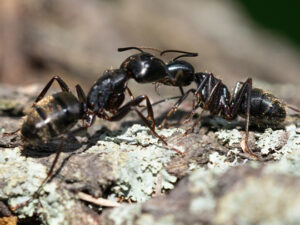
Odorous house ants, carpenter ants, Pharaoh ants, and pavement ants are among the commonly encountered ant pests within upstate New York homes. Although these ant species are ubiquitous in the northeast, they are technically non-native species that have become established in most inhabited regions of the world due to their tendency to hitch rides in shipping containers. These ants are aptly known as “tramp ants,” and they are particularly abundant in the northeast, as the region has been a major international shipping hub for centuries. While many ants are capable of stinging humans, one particular tramp ant species, the pavement ant, is capable of inflicting stings that result in serious allergic reactions, including anaphylactic shock.
According to a 2016 nationwide survey of pest control professionals, pavement ants were the second most commonly encountered ant pests within US homes, and Dr. Michael F. Potter, a professor of urban entomology, states that pavement ants are one of the most common ant pest species found in northeastern homes. Despite their commonality as indoor pests, it is not yet known whether pavement ants inflict structural or property damage, but they are well known to nest both within and near homes where they are commonly found skittering across sidewalks and other paved surfaces. Pavement ant colonies contain hundreds of thousands of individual ants, and they seek out a variety of indoor food sources, such as sweets, meats, and greasy foods. While not well known, several reports describe medically significant consequences of pavement ant stings.
Not long ago, a 25 year-old woman suffered severe systemic effects in response to a sting inflicted by a pavement ant within her home. Although the sting was reported as being painful, no pustules formed at the site of the bite wound. Immediately after the sting, however, the woman experienced itching, puffy eyes, respiratory difficulty and erythema. Twenty minutes later, and after having taken two oral antihistamines, the woman was brought into an emergency room with respiratory distress, generalized urticaria (hives) and decreased blood pressure. The woman made a full recovery after being treated with epinephrine and corticosteroids. Luckily, severe allergic reactions rarely result from pavement ant stings, but those with known allergies to arthropod venoms should consider these ants dangerous. Pavement ants can be recognized for their relatively small 3 mm length and reddish-brown to black exterior.
Have you ever sustained stings from what you believe were pavement ants?










